#an emergency indeed
Text
Hiccup, walking into his house: Hello, people who do not live here.
Astrid : Hey.
Fishlegs : Hi.
Ruffnut : Sup.
Snotlout : Hello.
Viggo : Hey!
Hiccup : I gave you the key to my place for emergencies only!
Tuffnut : It is an emergency!
Ryker : We were out of Doritos.
#an emergency indeed#we need more race to the edge asap#httyd#rtte#how to train your dragon#race to the edge#incorrect race to the edge quotes#incorrect how to train your dragon quotes#incorrect rtte quotes#incorrect httyd quotes#hiccup#tuffnut#ruffnut#viggo#ryker#astrid#snotlout#fishlegs
348 notes
·
View notes
Text






camina drummer in the expanse 5x03 - mother
#LOOSE HAIR DRUMMER! IM EXPERIENCING AN EMERGENCY#the expanse#theexpanseedit#scifiedit#wlwedit#tvedit#expanseblog#pocfiction#femalecharacters#camina drummer#cara gee#my post#*m.gif#what do i DO im not okay.#i FORGOT she ever lets her hair down and i was. unprepared.#using my newly acquired power for gay#mother indeed.
419 notes
·
View notes
Text


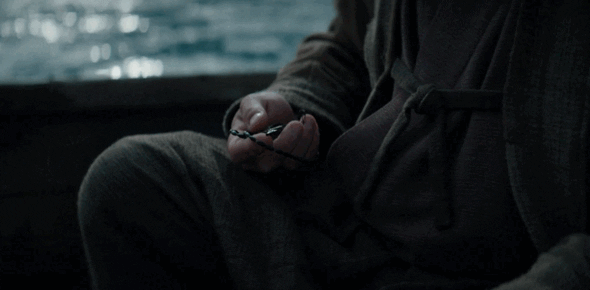
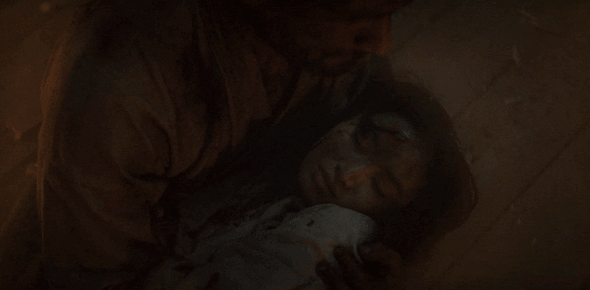

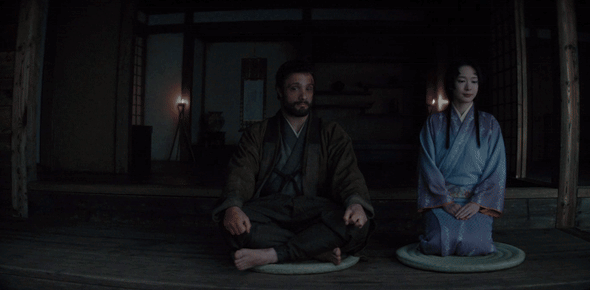

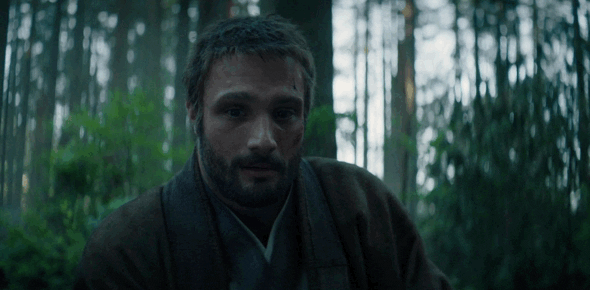


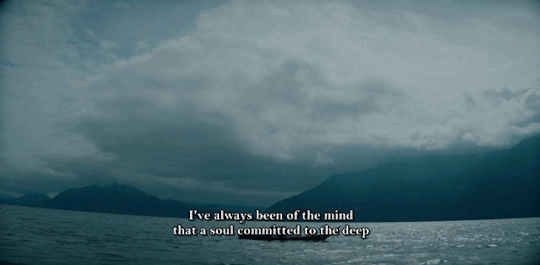







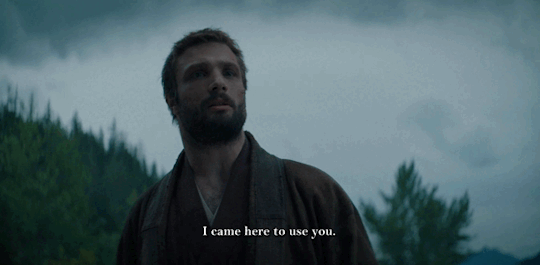
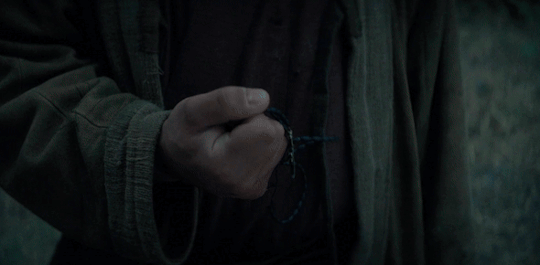

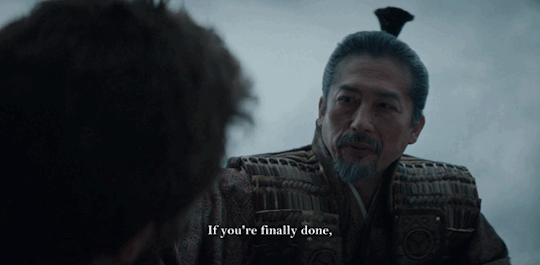
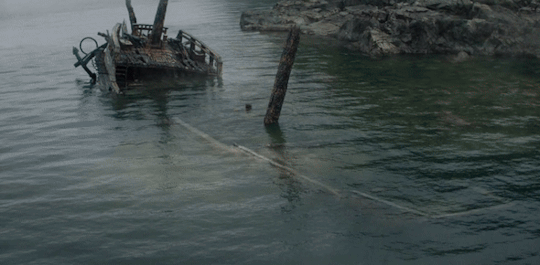




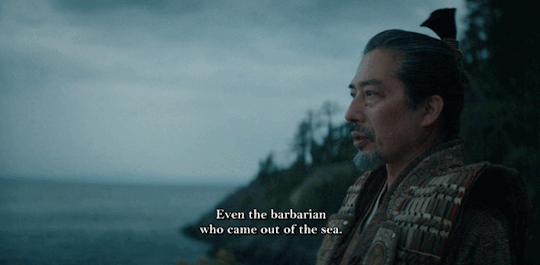
Shōgun (2024) | Chapter 10: “A Dream Of A Dream” | Favorite scenes
“Let your hands be the last to hold her.”
#GOD. THE FINALE. *sobbing*#john carrying mariko's cross like a lifeline :'(#“Let your hands be the last to hold her.” -> INDEED he was the last one to hold her *THIS SHIP i'm-*#“No translator.”+ the empty space where mariko used to sit... stabbed me right in the heart#the heartbreak on his face at losing his ship after losing mariko and then the joy at it emerging from the waters#shōgun#shogun 2024#shogun hulu#shogun fx#cosmo jarvis#john blackthorne#anna sawai#toda mariko#lady mariko#period drama#book adaptations#historical drama#hulu#tv shows#currently watching#gifs#mygifs#myedits#fx shogun#tv ships#shogunedit#ships#hands#ship dynamics#usami fuji
70 notes
·
View notes
Text
it always bugged me in movies when characters make like a blood pact with someone or a demon or something and they cut across their palm to get the blood 'cause it seemed like was a bit overkill and it also looked kinda painful but a few days ago i ended up doing that to myself in a very foolish woodworking accident (no demon pacts involved just me not being careful enough 😔 btw dont do woodworking at midnight) and lemme tell u i was RIGHT if u need blood for a demon pact DO NOT cut your hand it bleeds a lot and if u cut too deep or in the wrong spot your muscles get weird and nerves get all prickly and its hard to do so many things one handed I CANT imagine a demon pact would be worth it. just like i dunno. nosebleed on the summoning circle instead. respect yourself
#IM GOOD i didnt need stitches luckily. or maybe i mightve. but the emergency room was like a 10 hour wait so i used some like. medical glue#to glue it shut when it stopped bleeding after a few hours and got it checked out properly the next day when the doctors office was open LO#but yeah its healing fine! luckily im a very fast healer and i already have normal feeling back in most of my fingers#(the finger closest to the cut is still a little strange but it moves normal again and the pins and needles are almost gone!)#though sometimes i forget about the bandaged cut itself and put too much pressure on it and then im like#stock scream sound effect#but yeah we're good!! heed my advice dear followers: do not do any woodwork at midnight while being stressed out from deadlines and likely#intensely iron deficient from a combination of having chronic issues plus getting bloodwork done earlier in the day. <3#foolish woodworking accident indeed ghfhjhsklirjediufods
11 notes
·
View notes
Text
checking my email and seeing this:


racing to AO3 and then seeing this:
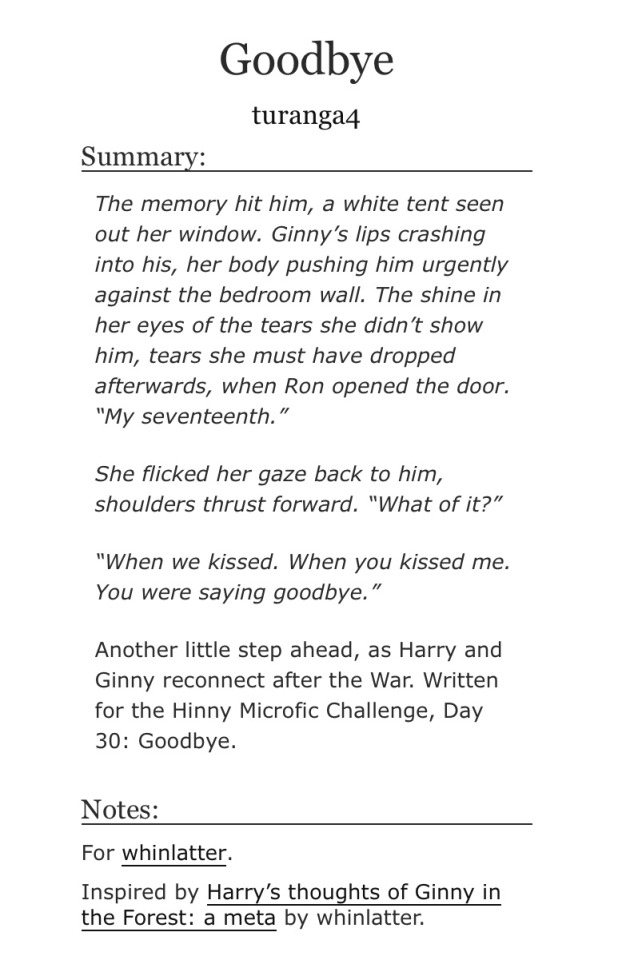

seeing Orchards quoted before the postwar hinny microfic of my dreams and deciding to just pack a bag and head out because it’s all too much for me to handle (they are talking! about the birthday kiss! for crying out loud!)


@turanga4 did someone bring my birthday forward six months and not tell me because honestly this fic is truly such a gift! 🎁🥹❣️
#goodbye INDEED#turanga gifted me a microfic and it made me macro happy#the way this has made my WEEK#cleared my skin paid my bills cleaned my house parked my car solved the climate emergency#fic rec#hinny#harry x ginny
29 notes
·
View notes
Text
.
#married mutuals be like#im going on the plane now give them your Spotify details now there's something with louis#and i immediately get the urgency like yes sir this is indeed an emergency ill save you
2 notes
·
View notes
Photo
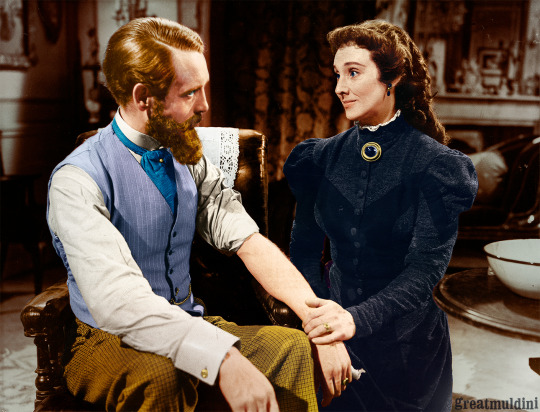
The events of 6 December 1890 were neither preordained nor were they premeditated. Nothing that transpired on the day was inevitable or irreversible: participants chose to stay in character, and to act out their roles in what would eventually be described by biographers and historians as the Parnell Tragedy (Jules Abels, 1966).
Everyone at the time would have been aware of the historical significance of their actions, if not the long-term consequences - excluding of course, the one female member of the cast who could not possibly have known what she was doing. By dint of this congenital deficiency she would also quite naturally be blamed for causing "Ireland's misfortune." Simple and satisfying in terms of its mass market appeal, feminine impulsivity does little to explain the supposedly rational decisions taken by the men around her in the name of patriotism and political expediency - which far from producing an amenable solution served only to exacerbate the crisis. Whereas the exact circumstances and full cast of characters have faded over time the larger-than-life figure of Charles Stewart Parnell still towers over the events of 6 December 1890 as the one man who could have had it all - and lost it all.
Sixty-four years later, the Fall of Parnell inspired an episode of the BBC's "experimental" television series You Are There which set out to present the known historical facts, faithfully, but with an added dimension unique to the new medium: actors would impersonate the key personnel as in a conventional re-enactment. While going about their "business," however, they would be interviewed by modern television reporters. The curious anachronism underlined the artificiality of the concept; it meant the programme was deliberately drawing attention to itself which would have been an unwanted distraction, for You Are There it was the defining feature. Neither the programme nor its - fictitious - journalists were interested in the exploration of alternative histories or in-depth character studies: the point was to demonstrate the possibilities of "live" television, ironically, in a simulated setting. Fact and fiction are trading places as the reality of 1890 becomes the subject of a 1950s fantasy, and the medium of the future interrogates the evidence of the past. For the actors it would have been a challenge to navigate between imaginative portrayal of a fully formed human being and the faithful rendition of the intrinsically incomplete historical record.
The historical record states that Charles Stewart Parnell was born in 1846. The son of a Protestant Irish landowner and an American mother was not naturally predestined to champion the cause of destitute Catholic tenant farmers; indeed, nothing in his early life pointed to any such leanings. As an aristocratic country gentleman he had nothing to fear and everything to gain from the firm imperial rule exerted by the British Crown over the Island of Ireland.
And yet it was Parnell, the English-educated man of pedigree, who emerged as the voice of the starving rural population. Having decided to enter politics for reasons that are still unclear, he found his calling as the Westminster MP for County Meath not in the defence of privilege but in the vocal support - initially for land reform and then increasingly for Irish nationalism ("Home Rule"). Over the next five years Parnell gained a reputation and a following as a fiery orator back in Ireland and a force to be reckoned with in the House of Commons, where is name became synonymous with the new parliamentary tactic of "obstructionism." If the English politicians could not be moved to act in Ireland's interest Parnell vowed to meddle in English affairs. And meddle - or obstruct - he did. After a century of inaction and neglect, the Irish Question seemed relevant again, if only because its proponents made it impossible for English laws to be passed. Parnell seemed to thrive on his tactical manoeuvring which he was prepared to carry to painful extremes, on multiple occasions – including arrest and imprisonment, at the risk of damaging his already fragile state of health.
By 1880 Parnell controlled both the radical grassroots movement in Ireland and the parliamentary representation of Irish interests in London. The position made him a frequent dinner guest in the homes of friends and allies, where on several occasions he also enjoyed the hospitality of Mrs Katharine O'Shea, the English wife of a fellow Irish MP, who was sympathetic not only to the cause but to the man who personified the struggle. Mrs O’Shea had a discreet arrangement with her husband, Captain William “Willie” O’Shea, the Member for County Clare and Galway: their marriage would exist on paper only for the benefit of Willie’s career; while he conducted his business in London she would reside at their official family residence and entertain important visitors. Parnell would often stay as a guest of the family - to recuperate after gruelling campaigns in Ireland, was the official explanation given.
For the next ten years the couple conducted an illicit affair that produced four children and saw the singled-minded saboteur of the political system lead a double life away from Parliament and in the company of Katharine O’Shea. The relationship was not as one might assume a tempestuous whirlwind romance but a curiously claustrophobic still-life of Victorian domesticity - an alternate, self-contained reality where Parnell and his "Queenie" could act out their fantasy of living simply as husband and wife. Their apparent longing for simplicity may also help to explain the ease with which they expected to lead two entirely separate and parallel lives, apparently unaware of or unwilling to acknowledge the inherent paradox and inevitable complication.
In the political arena Parnell was for most of the 1880s an extremely effective manipulator of moods and opinions, always weighing and adjusting the demands of Irish nationalists against the calls for the use of force from the British press, the public, and its politicians. Anyone looking for a core belief or deeply held conviction would have been disappointed by the vagueness of Parnell's own stated aims - which he used to great advantage because it allowed him to gain the confidence of the British side and the respect of his own following. As a small but significant minority, the Irish (or Home Rule) Party under Parnell's skilful machinations was able to make demands in return for the votes it lent to either one of the two dominant forces in 19th century British politics: the Tory (Conservative) Party or the slightly more reform-oriented Liberal Party.
Parnell’s elusiveness became his trademark: the less he said in public, the fewer appearances he made in Parliament, the taller he grew in stature. In 1887 he was accused of having endorsed the murders of two British politicians in Dublin. When the alleged endorsement turned out to be a forgery two years later, the popular reaction was one of relief and renewed admiration for the noble freedom fighter who had been so horribly maligned. By 1889, it seemed as if nothing could go wrong for Charles Stewart Parnell.
Home Rule seemed within reach when, in May of 1889, Katharine O'Shea learned of the death of a wealthy aunt whose fortune she was to inherit. The additional funds would have been a welcome boost to Katharine's finances had it not been for her husband's unexpected interference. Captain William “Willie” O’Shea chose this moment to strike, possibly to exact revenge, more likely to improve his own pecuniary situation. And thus, Captain O'Shea went ahead and contested the will, citing his wife’s infidelity, and his intention to divorce her. Surprised but hardly alarmed, the lovers welcomed what they thought would be an opportunity for them to make their relationship official, the sooner the better.
From the very beginning their affair had been an open secret in political circles, but the Captain’s announcement put the fact of their adultery in the public domain. With their case not due in court for at least another twelve months (i.e. late 1890), Katharine and Parnell were powerless to stop the scandal from spreading, and their silence on the matter allowed grievances to fester. No public statement was ever published, nor did the couple make any public gesture of remorse. They did launch a half-hearted and unsuccessful counterclaim not to deny the adultery but to accuse Captain O’Shea of adultery as well, presumably to shame the Captain into withdrawing his allegation.
For an entire year the unresolved state of their private affairs overshadowed Parnell’s political battle; it affected his health and continued to corrode confidence among his allies in parliament and at home but most significantly among the ranks of the Liberal Party led by Prime Minister William Gladstone. Ironically, and with tragic consequences for Katharine and Parnell, the earliest and most vociferous condemnations came not from the Catholic Church (both Parnell and Katharine were Protestants) but from the other “Nonconformist” denominations outside the established Church of England, which was traditionally a preserve of the Tory (Conservative) Party. An influential group among the Nonconformists were Methodists, whose large working and middle-class following had found in Gladstone’s Liberal Party their political home.
When the divorce eventually came through in November 1890 (decree nisi), Parnell was branded a “convicted adulterer” but also won the legal right to marry Katharine after completion of the obligatory six-month waiting period (decree absolute). The salacious - and uncontested – testimony offered in the course of the trial was, however, fresh on the minds of his party colleagues who were meeting to decide on his future as party leader a mere fortnight after the court’s decision. Gladstone had already warned Irish MPs of the danger to their alliance, the implication being that the Liberal Party would lose the support of its Nonconformist base if it continued to cooperate with a “convicted adulterer.” The message was clear: Irish MPs had no hope of winning Home Rule with Parnell as their leader. They needed the good will and legislative might of a strong Liberal government - and Liberal voters had strong ideas about marriage and adultery. Gladstone did, in effect, issue an ultimatum to Irish parliamentarians: lose your leader or lose Ireland.
Party activists in Ireland meanwhile re-elected Parnell as leader of the Home Rule Party before news of the ultimatum reached their shores, creating an awkward situation which allowed Parnell to claim he had the backing of the party rank and file, while Gladstone faced the beginnings of a split in his own party over the very issue of Irish Home Rule.
Parnell promptly refused to stand down, declaring instead that he considered the matter of Mrs O’Shea’s divorce closed and that, far from being a friend of Ireland, Gladstone had betrayed their cause. Whether or not the accusation was based in fact [substance] hardly mattered in the greater scheme of things. It was Parnell's word against that of the Prime Minister, and a decision had to be made: should the Irish Home Rule Party defy Gladstone and keep Parnell as their charismatic leader, or should the convicted adulterer be deposed in return for English concessions?
On 6 December 1890, after seemingly endless negotiations, Irish parliamentarians convened another marathon session to break the deadlock without destroying the party, its leader, or their country. Obstacles proved insurmountable as Parnell himself chaired the meeting and overruled any motion calling for a vote. Members present at the meeting noted his increasingly autocratic behaviour with concern and were alarmed by the apparent disintegration of his mental and physical identity. What they were witnessing may have been, on one level, the self-evisceration of a disgraced politician, but the concrete struggle of the individual to control his own destiny, and the narrative about it, had gained additional layers of meaning that transcend literal explanations for Parnell's fate.
The extent to which he did control the mythology of his downfall as well as his subsequent (and posthumous) apotheosis is a fascinating subject for debate: was he drawing attention to the opposing forces behind his identity or trying to deflect attention away from his failure to reconcile the two when he claimed that Gladstone and the Liberals were the true enemies of the rightful Irish claim to self-determination? No longer was the crisis a moral dilemma but a question of national pride. The private transgression becomes an affair of state - no longer is it a moral dilemma but a question of national pride: if it was up to the English to dictate who is to be their leader, then Gladstone truly was the master of the Irish Party.
Parnell's rhetorical masterstroke elevated his imminent ouster as party leader to an affront of international proportions by blurring the very boundaries he had otherwise hoped to maintain between the private man and his public persona. It also drew an instant reaction from the assembled party colleagues. "Who is to be the mistress of the party?” put paid to Parnell's noble-minded aspirations and reminded those present once again of the sordid scandal and the root cause of their troubles. Unable to vote the party leader out of office, 44 of his fellow members stood up and left the room, 26 remained with Parnell. It is this moment You Are There chose to dramatize, for the sheer symbolism of the scene: the leader without majority, his party crippled for decades to come. The Liberal Prime Minister ruling unencumbered.
Parnell's story, the story of Ireland's struggle, could have ended here. Or it could have ended differently. If each of the protagonists had chosen a different course of action. Parnell, for his part, chose to fulfil what he must have thought of as his destiny: within hours of the party meeting that left him - it must be remembered - still nominally undefeated, he embarked on a tour of Ireland to speak at rallies and unite the crowds behind the candidates he chose to stand in by-elections. Any hopes of regaining the momentum lost in London were slim at best; the winter weather and Parnell's failing health reduced the schedule and, compounded by his ever more radical oratory, crowds became more difficult to control, and enthusiasm for the struggle was waning. But just as the chances of a concrete, real-life settlement were growing increasingly remote, the idea of the struggle captured the imagination of contemporary and subsequent generations, and Parnell became its idealized figurehead - not without considerable work from Parnell himself, who cultivated an air of steely nerves, superhuman strength, and emotional detachment in public while being fiercely protective of his privacy. The polar opposites that defined his existence, through their very incompatibility, presented an impossible conundrum: unable to reconcile the two, incapable of compromise, the Parnell machine was at a crisis point.
Campaigning in Ireland continued throughout the summer but none of the chosen candidates were victorious. Parnell and Katharine finally became a married couple on 25 June 1891, but their life together as husband and wife only lasted a little over three months and ended with Parnell’s death on 6 October 1891. They were both 45 years old at the time.
In poetic terms, Parnell had committed the ultimate sin of the tragic hero: to think of himself as indispensable. In the eyes of his supporters, and presumably his own, Parnell had become the personification of an idea, an idea that without him was thought to be non-viable. Parnell and Irish Home Rule were interchangeable; the means and the end had merged into one. Much like the fatal flaw carried by every tragic hero in the history of human endeavour, Parnell's hubris made him both unique and universal, gave him superhuman powers and made him vulnerable - not in a simple case of crime and punishment but in the pursuit of a noble mission that is ultimately larger than the man who has internalized it as his own.
To paraphrase Hilary Mantel, we tend to fictionalize those who can no longer speak for themselves; in Parnell's case there is perhaps a greater need than with many of his peers to interpret where we cannot explain, and to speculate were we cannot know.
Indeed, so strong was the sense even among contemporaries of a catastrophic derailment of their hopes and dreams, and so great the loss of confidence in the political process, it gave rise to an entire subgenre of historical fantasies indulging in mostly wishful thinking: what if Parnell's campaign had been successful and he had lived to see an independent Ireland? What if there had never been a scandal? What if we could turn the clock back far enough to prevent all bad things from happening? This being a male-centric scenario we easily move on to imagining the hero going about his business without "distractions," and what might have been if Parnell and Katharine O'Shea had never met. The further the fantasy travels back in time, however, the more it will be about erasure of the past rather than an extension of existing timelines. As a work of fiction, it may well be a legitimate subject for philosophical or even psychological enquiry that can provide a temporary reprieve from the struggle. It can never be the solution. [Part 2 of 2]
#Patrick McGoohan#Helen Shingler#were 26 and 35 years old respectively#when they portrayed Charles Stewart Parnell and Katharine O'Shea live on BBC TV#impossible casting by today's standards but in 1954#leading men were expected to cover a much wider age range#fortunately the BBC secured for the part#of the enigmatic giant of Irish nationalism#an actor whose heritage and disposition were an uncanny match#having played much older men on stage before as was indeed the practice in#repertory theatre and the tradition carried over into early television#interestingly the young talent that the new medium attracted in its experimental phase#later launched a televisual experiment of his very own in the pursuit of something#as elusive maybe as the source of Parnell's political ambition#whether it is life imitating art or patterns emerging in hindsight#we will interpret and fictionalize#compare and analyse to satisfy our own obsessions#because that is what this is really#who in their right mind would see shades of Parnell in Col Rumford#or the myth behind the man#for fleetstreetpauline always
24 notes
·
View notes
Text
as ever i am lowkey endlessly frustrated with the use of trauma in media
i don’t think depiction is inescapably endorsement and i certainly don’t believe media cannot sensitively handle fucked up subject matter
but how is trauma presented and who is it actually for are my bare minimum bars to clear, and so often that’s where the depiction falls through
#i had some feelings about the showrunners for house of the dragon making the emergency c-section about viserys’ pain#because that pain does exist! he was asked to make a horrific choice#but his horrific choice was about his wife’s body#and centering him and literally putting the scene in his perspective bothered me a lot#which… i am indeed boo-boo the fool putting on my own clown makeup for watching and i accept that truth#still: the fuck. right now? of all times? the fuck
37 notes
·
View notes
Text





someone get the doctor someone get the nurse someone buy me roses someone burn the church 😵💫
37 notes
·
View notes
Text
the sky got real dark real fast
#‘its night’ indeed#like a few weeks ago when i emerged from the supermarket and thought i had somehow been in there for the whole day#but it was just extreme weather#f1#WAIT are they stopping?? thats unfortunate#well stroll in p3 is a surprise so congrats to him#otherwise it sucks bc most of them werent given fair chances 😔#but if the weather’ll stay like that i guess theres no point to waiting it out
4 notes
·
View notes
Text

platinum not caring about looker's ass is very funny and pleasing to me
#pokespe liveblog#also very telling of their emerging dynamic#they've spent almost an entire volume together at this point and there is no fondness or closeness between the two#platinum is so clearly humoring looker as a means to an end#in a way this is a telling insight into what her journey would have been like if there hadn't been the mixup with dia and pearl#a world without Them is a cruel and bleak one indeed. i hope the sinnoh trio gets back together soon
2 notes
·
View notes
Text
last night I cut the ever loving fuck out of my right pinky finger at 10:30 at night, got to an NHS hospital at 11:00, got registered at 12:00, saw a nurse practitioner at 6:00, got five stitches at 7:30, got back to my flat at 8:00.
Consequently today has been a bed day
#the nurse inspected the cut very thoroughly#she invited me to have a look#I saw my tendon#it was indeed nipped#but not so much according to the hand specialist that I needed stitches on the tendon#also when you get a bigass cut and they inject you with that fuckin anesthetic#right into your damn cut#that hurts#however the bleeding then washed away a lot of the anesthetic so I still got to feel three of the five stitches#those also hurt#shoot#basically I would say that if you are going to have a medical emergency do not
16 notes
·
View notes
Text
The more I wonder this Pizzaplex the less and less it makes any god damn sense
#okay I get it's the gameplay.#I get that's game design.#I appreciate that.#but also what the FUCK is this building design.#the most unnapproved building to ever building#every regulatory board ever hates this building.#bro what IS this#lmao i know the long twisty halls are for loading times and I know the place is designed as a game first and foremost but MAN#trying to imagine a real world version of this or a version that makes sense for fic#and it's like trying to understand the fuckin' backrooms#but you know what?#with the only fire exit being locked behind a VIP only door#some of these things start to make sense as 'if its an emergency they'll pay' kind of thing#yikes man#yikes indeed
2 notes
·
View notes
Text

this book really came and punched me in the face
#note to self: stop reading emotionally devastating stuff during international travel#anyway london was really nice#even tho an atm ate my card and i had to make emergency bank calls 🤡#but the play was amazing#i bought too many books in my favourite store#and i found lots of cool weird things#i even went to an amsr exhibition 😅#special shoutout to all idiots who indeed stayed away from my workplace while I was gone bless
2 notes
·
View notes
Text
I can not IMAGINE living truly alone I need to be held accountable
#been solo in the home bc of house emergency#learned 2 things#1: i do indeed succumb to a kind of lethargic madness#as suspected#and 2: i eat. in an unacceptable way#too much. doing too much
3 notes
·
View notes
Text
Opinion Here’s how to get free Paxlovid as many times as you need it
When the public health emergency around covid-19 ended, vaccines and treatments became commercial products, meaning companies could charge for them as they do other pharmaceuticals. Paxlovid, the highly effective antiviral pill that can prevent covid from becoming severe, now has a list price of nearly $1,400 for a five-day treatment course.
Thanks to an innovative agreement between the Biden administration and the drug’s manufacturer, Pfizer, Americans can still access the medication free or at very low cost through a program called Paxcess. The problem is that too few people — including pharmacists — are aware of it.
I learned of Paxcess only after readers wrote that pharmacies were charging them hundreds of dollars — or even the full list price — to fill their Paxlovid prescription. This shouldn’t be happening. A representative from Pfizer, which runs the program, explained to me that patients on Medicare and Medicaid or who are uninsured should get free Paxlovid. They need to sign up by going to paxlovid.iassist.com or by calling 877-219-7225. “We wanted to make enrollment as easy and as quick as possible,” the representative said.
Indeed, the process is straightforward. I clicked through the web form myself, and there are only three sets of information required. Patients first enter their name, date of birth and address. They then input their prescriber’s name and address and select their insurance type.
All this should take less than five minutes and can be done at home or at the pharmacy. A physician or pharmacist can fill it out on behalf of the patient, too. Importantly, this form does not ask for medical history, proof of a positive coronavirus test, income verification, citizenship status or other potentially sensitive and time-consuming information.
But there is one key requirement people need to be aware of: Patients must have a prescription for Paxlovid to start the enrollment process. It is not possible to pre-enroll. (Though, in a sense, people on Medicare or Medicaid are already pre-enrolled.)
Once the questionnaire is complete, the website generates a voucher within seconds. People can print it or email it themselves, and then they can exchange it for a free course of Paxlovid at most pharmacies.
Pfizer’s representative tells me that more than 57,000 pharmacies are contracted to participate in this program, including major chain drugstores such as CVS and Walgreens and large retail chains such as Walmart, Kroger and Costco. For those unable to go in person, a mail-order option is available, too.
The program works a little differently for patients with commercial insurance. Some insurance plans already cover Paxlovid without a co-pay. Anyone who is told there will be a charge should sign up for Paxcess, which would further bring down their co-pay and might even cover the entire cost.
Several readers have attested that Paxcess’s process was fast and seamless. I was also glad to learn that there is basically no limit to the number of times someone could use it. A person who contracts the coronavirus three times in a year could access Paxlovid free or at low cost each time.
Unfortunately, readers informed me of one major glitch: Though the Paxcess voucher is honored when presented, some pharmacies are not offering the program proactively. As a result, many patients are still being charged high co-pays even if they could have gotten the medication at no cost.
This is incredibly frustrating. However, after interviewing multiple people involved in the process, including representatives of major pharmacy chains and Biden administration officials, I believe everyone is sincere in trying to make things right. As we saw in the early days of the coronavirus vaccine rollout, it’s hard to get a new program off the ground. Policies that look good on paper run into multiple barriers during implementation.
Those involved are actively identifying and addressing these problems. For instance, a Walgreens representative explained to me that in addition to educating pharmacists and pharmacy techs about the program, the company learned it also had to make system changes to account for a different workflow. Normally, when pharmacists process a prescription, they inform patients of the co-pay and dispense the medication. But with Paxlovid, the system needs to stop them if there is a co-pay, so they can prompt patients to sign up for Paxcess.
Here is where patients and consumers must take a proactive role. That might not feel fair; after all, if someone is ill, people expect that the system will work to help them. But that’s not our reality. While pharmacies work to fix their system glitches, patients need to be their own best advocates. That means signing up for Paxcess as soon as they receive a Paxlovid prescription and helping spread the word so that others can get the antiviral at little or no cost, too.
{source}
6K notes
·
View notes